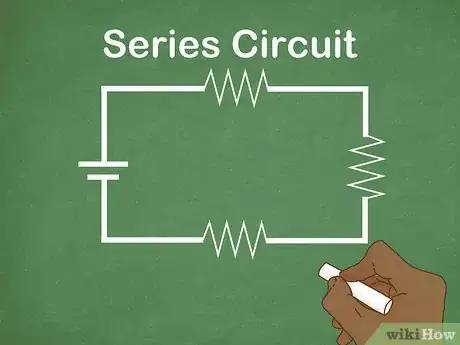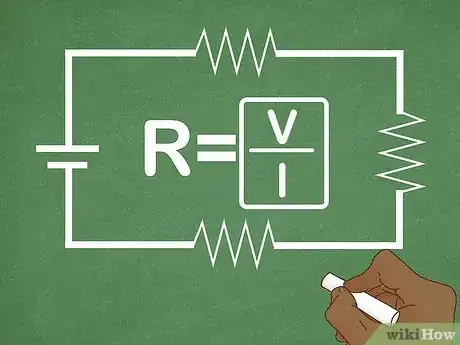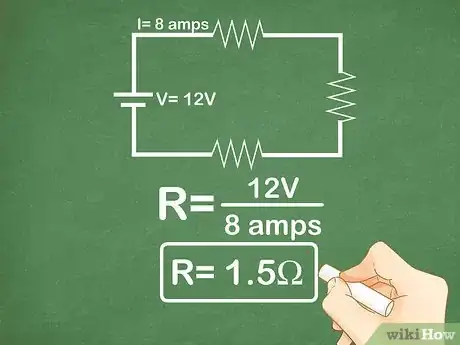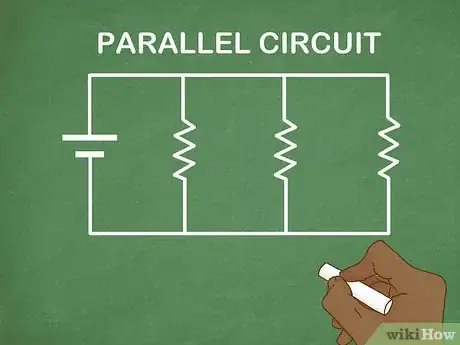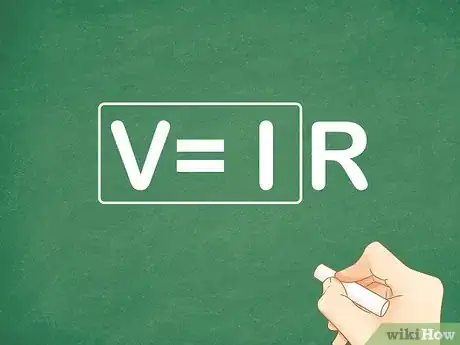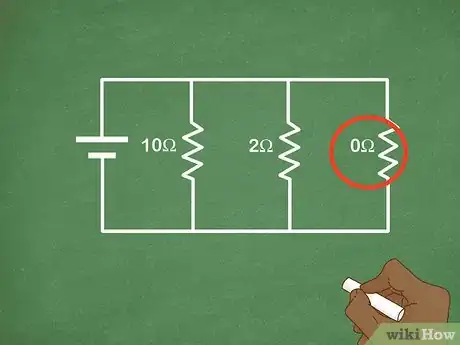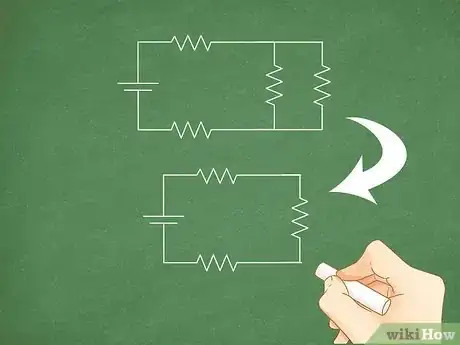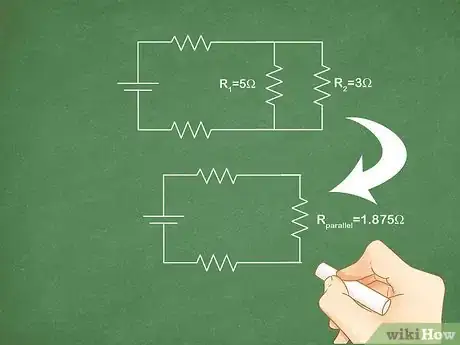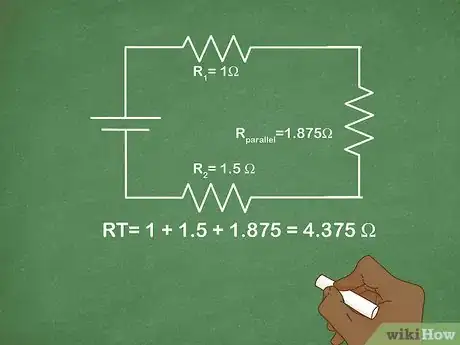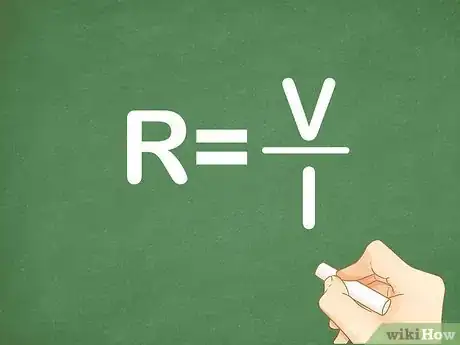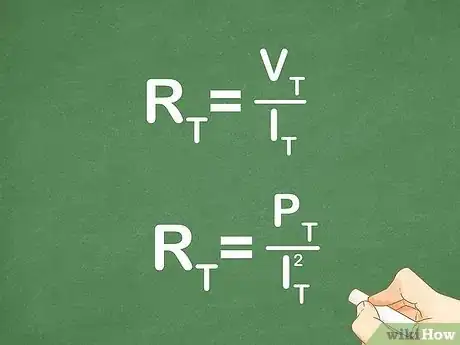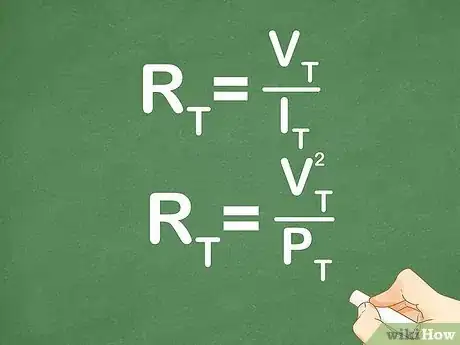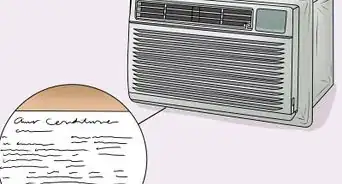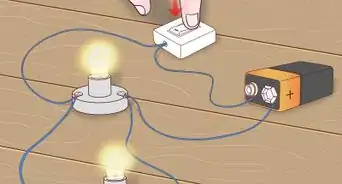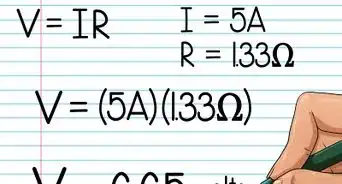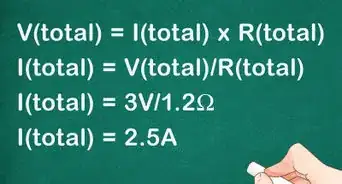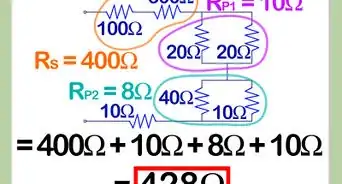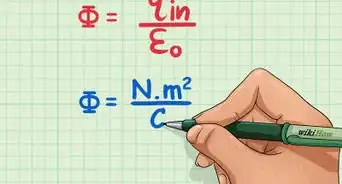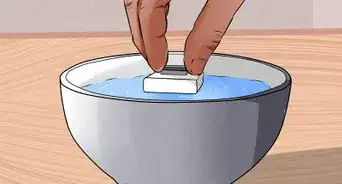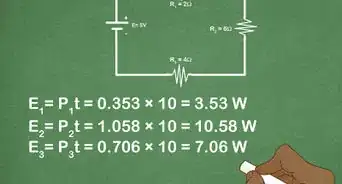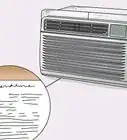This article was co-authored by Marvin Woo. Marvin Woo is a licensed electrician and the Owner of Woo's Electrical & Appliance based in East O’ahu. With over two decades of experience, he specializes in troubleshooting issues and maintaining residential electrical systems. Marvin is both licensed and insured to complete electrical work in the state of Hawaii.
There are 9 references cited in this article, which can be found at the bottom of the page.
This article has been viewed 1,758,056 times.
There are two ways to hook together electrical components. Series circuits use components connected one after the other, while parallel circuits connect components along parallel branches. The way resistors are hooked up determines how they contribute to the total resistance of the circuit.
Steps
Series Circuit
-
1Identify a series circuit. A series circuit is a single loop, with no branching paths. All the resistors or other components are arranged in a line.
-
2Add all resistances together. In a series circuit, the total resistance is equal to the sum of all resistances.[1] The same current passes through each resistor, so each resistor does its job as you would expect.
- For example, a series circuit has a 2 Ω (ohm) resistor, a 5 Ω resistor, and a 7 Ω resistor. The total resistance of the circuit is 2 + 5 + 7 = 14 Ω.
Advertisement -
3Start with current and voltage instead. If you don't know the individual resistance values, you can rely on Ohm's Law instead: V = IR, or voltage = current x resistance. The first step is to find the circuit's current and total voltage:
-
4Insert these values into Ohm's Law. Rearrange V = IR to solve for resistance: R = V / I (resistance = voltage / current). Plug the values you found into this formula to solve for total resistance.
- For example, a series circuit is powered by a 12 volt battery, and the current is measured at 8 amps. The total resistance across the circuit must be RT = 12 volts / 8 amps = 1.5 ohms.
Parallel Circuit
-
1Understand parallel circuits. A parallel circuit branches into multiple paths, which then join back together. Current flows through each branch of the circuit.
- If your circuit has resistors on the main path (before or after the branched area), or if there are two or more resistors on a single branch, Skip down to the combination circuit instructions instead.
-
2Calculate the total resistance from the resistance of each branch. Since each resistor only slows current passing through one branch, it only has a small effect on the total resistance of the circuit. The formula for total resistance RT is , where R1 is the resistance of the first branch, R2 is the resistance of the second branch, and so on up to the last branch Rn.
- For example, a parallel circuit has three branches, with resistances of 10 Ω, 2 Ω, and 1 Ω.
Use the formula and solve for RT:
Convert fractions to a common denominator:
Multiply both sides by RT: 1 = 1.6RT
RT = 1 / 1.6 = 0.625 Ω.
- For example, a parallel circuit has three branches, with resistances of 10 Ω, 2 Ω, and 1 Ω.
-
3Begin with total current and voltage instead. If you don't know the individual resistances, you'll need the current and voltage instead:
- In a parallel circuit, the voltage across one branch is the same as the total voltage across the circuit.[4] As long as you know the voltage across one branch, you're good to go. The total voltage is also equal to the voltage of the circuit's power source, such as a battery.
- In a parallel circuit, the current may be different along each branch. You need to know the total current, or you won't be able to solve for total resistance.
-
4Use these values in Ohm's Law. If you know the total current and the voltage across the whole circuit, you can find the total resistance using Ohm's Law: R = V / I.
- For example, a parallel circuit has a voltage of 9 volts and total current of 3 amps. The total resistance RT = 9 volts / 3 amps = 3 Ω.
-
5Watch out for branches with zero resistance. If a branch on the parallel circuit has no resistance, all of the current will flow through that branch. The resistance of the circuit is zero ohms.
- In practical applications, this usually means a resistor has failed or been bypassed (short-circuited), and the high current could damage other parts of the circuit.[5]
Combination Circuit
-
1Break down your circuit into series sections and parallel sections. A combination circuit has some components linked together in series (one after the other), and others in parallel (on different branches). Look for areas of your diagram that simplify to a single series or parallel section.[6] Circle each one to help you keep track of them.
- For example, a circuit has a 1 Ω resistor and a 1.5 Ω resistor connected in series. After the second resistor, the circuit splits into two parallel branches, one with a 5 Ω resistor and the other with a 3 Ω resistor.
Circle the two parallel branches to separate them from the rest of the circuit.
- For example, a circuit has a 1 Ω resistor and a 1.5 Ω resistor connected in series. After the second resistor, the circuit splits into two parallel branches, one with a 5 Ω resistor and the other with a 3 Ω resistor.
-
2Find the resistance of each parallel section. Use the parallel resistance formula to find the total resistance of a single parallel section of the circuit.[7]
- The example circuit has two branches with resistance R1 = 5 Ω and R2 = 3 Ω.
Ω
- The example circuit has two branches with resistance R1 = 5 Ω and R2 = 3 Ω.
-
3Simplify your diagram. Once you've found the total resistance of a parallel section, you can cross out that whole section on your diagram. Treat that area as a single wire with resistance equal to the value you found.
- In the example above, you can ignore the two branches and treat them as one resistor with resistance 1.875Ω.
-
4Add up resistances in series. Once you've replaced each parallel section with a single resistance, your diagram should be a single loop: a series circuit. The total resistance of a series circuit is equal to the sum of all individual resistances, so just add them up to get your answer.
- The simplified diagram has a 1 Ω resistor, 1.5 Ω resistor, and the section with 1.875 Ω you just calculated. These are all connected in series, so Ω.
-
5Use Ohm's Law to find unknown values. If you do not know the resistance in one component of your circuit, look for ways to calculate it. If you know the voltage V and current I across that component, find its resistance using Ohm's Law: R = V / I.
Formulas Using Power
-
1Learn the formula for power. Power is the rate that the circuit consumes energy, and the rate it delivers energy to whatever the circuit is powering (such as a light bulb).[8] The total power of a circuit is equal to the product of the total voltage and the total current. Or in equation form: P = VI.[9]
- Remember, when solving for total resistance, you need to know the total power of the circuit. It's not enough to know the power flowing through one component.
-
2Solve for resistance using power and current. If you know these two values, you can combine two formulas to solve for resistance:
- P = VI (power = voltage x current)
- Ohm's Law tells us that V = IR.
- Substitute IR for V in the first formula: P = (IR)I = I2R.
- Rearrange to solve for resistance: R = P / I2.
- In a series circuit, the current across one component is the same as the total current. This is not true for a parallel circuit.
-
3Find resistance from power and voltage. If you only know the power and voltage, you can use a similar approach to find resistance. Remember to use the total voltage across the circuit, or the voltage of the battery powering the circuit:
- P = VI
- Rearrange Ohm's Law in terms of I: I = V / R.
- Substitute V / R for I in the power formula: P = V(V/R) = V2/R.
- Rearrange to solve for resistance: R = V2/P.
- In a parallel circuit, the voltage across one branch is the same as the total voltage. This is not true for a series circuit: the voltage across one component is not the same as the total voltage.
- Alternatively, you can isolate the circuit and physically test resistance using a multimeter. [10]
Community Q&A
-
QuestionHow do I calculate the resistance of 2 resistors when I know the sum of the resistors?
 Community AnswerAssuming you mean total resistance, you first need to determine if they are in series or parallel. In series the total resistance simply equals the sum of the resistors. In parallel, the inverse of the total resistance equals the sum of the inverse of each individual resistor. Therefore, you will not be able to calculate total resistance in a parallel circuit if you only know the sum.
Community AnswerAssuming you mean total resistance, you first need to determine if they are in series or parallel. In series the total resistance simply equals the sum of the resistors. In parallel, the inverse of the total resistance equals the sum of the inverse of each individual resistor. Therefore, you will not be able to calculate total resistance in a parallel circuit if you only know the sum. -
QuestionIf V = IR, how do I calculate if one cell = 2V and the resistor is 4 ohm?
 Community AnswerI = V/R . This is derived from the equation V =I R. In the question the value of potential difference (v) is mentioned as 2V, i.e, 2 volts. The value of resistance of the resistor is given as 4 ohms. Substitute these values in the first equation; i.e, l = V/R, so, I = 2/4. Therefore, I = 0.5 amps.
Community AnswerI = V/R . This is derived from the equation V =I R. In the question the value of potential difference (v) is mentioned as 2V, i.e, 2 volts. The value of resistance of the resistor is given as 4 ohms. Substitute these values in the first equation; i.e, l = V/R, so, I = 2/4. Therefore, I = 0.5 amps. -
QuestionCan I use frequency to calculate resistance?
 Community AnswerResistance does not change with frequency. However, AC circuits do have a similar quality called reactance which does change with frequency. Learn more here.
Community AnswerResistance does not change with frequency. However, AC circuits do have a similar quality called reactance which does change with frequency. Learn more here.
References
- ↑ http://www.bbc.co.uk/bitesize/higher/physics/elect/resistors/revision/1/
- ↑ http://www.bbc.co.uk/bitesize/higher/physics/elect/resistors/revision/1/
- ↑ http://www.physicsclassroom.com/class/circuits/Lesson-4/Combination-Circuits
- ↑ https://www.swtc.edu/ag_power/electrical/lecture/parallel_circuits.htm
- ↑ http://www.allaboutcircuits.com/textbook/direct-current/chpt-5/component-failure-analysis/
- ↑ Marvin Woo. Licensed Electrician. Expert Interview. 31 January 2022.
- ↑ Marvin Woo. Licensed Electrician. Expert Interview. 31 January 2022.
- ↑ http://www.physicsclassroom.com/Class/circuits/u9l2d.cfm
- ↑ http://hyperphysics.phy-astr.gsu.edu/hbase/electric/elepow.html
About This Article
To calculate total resistance in series circuits, look for a single loop with no branching paths. Add all of the resistances across the circuit together to calculate the total resistance. If you don’t know the individual values, use the Ohm’s Law equation, where resistance = voltage divided by current. Plug in the values for voltage and current and solve for R to get the total resistance in a circuit. Keep reading the article if you want to learn how to calculate the resistance on a parallel or combination circuit!
